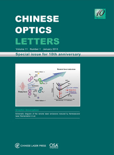
Chinese Optics Letters
Scope & Guideline
Transforming knowledge into optical advancements.
Introduction
Aims and Scopes
- Optical Materials and Devices:
Research on novel materials and devices that enhance optical performance, including studies on lithium niobate, perovskites, and other photonic materials. - Laser Technologies:
Focus on advancements in laser technology, including high-power lasers, fiber lasers, and novel laser configurations for various applications. - Optical Communication:
Exploration of optical communication systems, including visible light communication, fiber optics, and integrated photonic circuits, aimed at improving data transmission efficiency. - Imaging Techniques:
Innovations in imaging technologies, including ghost imaging, holography, and microscopy, particularly in enhancing resolution and sensitivity. - Quantum Optics:
Investigation into quantum phenomena in optics, including quantum imaging, entanglement, and applications of quantum mechanics in enhancing optical systems. - Metasurfaces and Nanophotonics:
Research on metasurfaces and nanostructured materials that manipulate light at the nanoscale, with applications ranging from sensors to imaging systems. - Nonlinear Optics:
Studies focusing on nonlinear optical effects, including frequency conversion, soliton dynamics, and other nonlinear phenomena in optical materials. - Optical Sensors and Measurement Techniques:
Development of advanced optical sensors and measurement techniques, including fiber-optic sensors and laser-based measurement systems for various applications.
Trending and Emerging
- Integrated Photonic Systems:
There is a growing emphasis on integrated photonic systems that combine various optical functions on a single chip, enhancing performance and reducing size for applications in telecommunications and sensing. - Quantum Technologies:
Research into quantum technologies, including quantum imaging, entangled photon sources, and quantum communication, is gaining momentum, reflecting the broader interest in harnessing quantum mechanics for practical applications. - Nonlinear Optical Materials:
Emerging studies focus on novel nonlinear optical materials and their applications in frequency conversion, soliton generation, and other nonlinear phenomena, indicating a renewed interest in exploring their capabilities. - Machine Learning in Optics:
The application of machine learning and artificial intelligence in optics is trending, with researchers exploring its potential for improving imaging systems, data analysis, and optical device design. - Sustainable and Green Photonics:
There is an increasing focus on sustainable materials and processes in photonics, including the development of eco-friendly optical devices and energy-efficient laser technologies. - High-Resolution and Advanced Imaging Techniques:
Research into high-resolution imaging techniques, including super-resolution microscopy and advanced computational imaging methods, is on the rise, driven by demands for enhanced imaging capabilities in various fields. - Metamaterials and Topological Photonics:
The exploration of metamaterials and topological photonics is expanding, with researchers investigating their unique properties for applications in sensing, imaging, and light manipulation.
Declining or Waning
- Traditional Optical Components:
There appears to be a decrease in research focused on conventional optical components such as lenses and mirrors, as the field increasingly favors integrated and miniaturized solutions, particularly in the context of photonic circuits. - Basic Theoretical Models:
Research papers relying heavily on basic theoretical models without experimental validation or novel applications have become less frequent, indicating a shift towards more empirical and application-driven studies. - Conventional Imaging Techniques:
Interest in traditional imaging techniques, such as standard optical microscopy, has waned as researchers gravitate towards more advanced imaging modalities that incorporate new technologies like AI and machine learning. - Long-Established Laser Technologies:
Research on long-established laser technologies, particularly those with limited advancements, is declining in favor of innovative laser systems and configurations that offer new functionalities.
Similar Journals
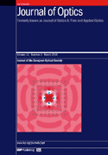
Journal of Optics
Exploring the Frontiers of Optical ScienceThe Journal of Optics, published by IOP Publishing Ltd, stands as a pivotal platform for disseminating cutting-edge research in the fields of atomic, molecular physics, and optics as well as electronic, optical, and magnetic materials. With an impact factor reflective of its esteemed position—ranking in the 60th percentile in both relevant Scopus categories—this journal, boasting an ISSN of 2040-8978 and an E-ISSN of 2040-8986, is uniquely positioned to foster innovation and collaboration among researchers, professionals, and students worldwide. Located in the United Kingdom and operational since 2010, the journal embraces an open access model, promoting maximal reach and engagement with the latest discoveries that shape the future of optics. As it continues to evolve through its converged years up to 2024, the Journal of Optics remains a critical resource for those seeking to advance their knowledge and influence in this dynamic field.
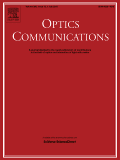
OPTICS COMMUNICATIONS
Shaping Tomorrow's Technologies with LightOptics Communications, published by Elsevier, is a prestigious international journal that focuses on the dynamically evolving fields of optics and photonics. With its ISSN 0030-4018 and E-ISSN 1873-0310, this journal has made significant contributions to the fields of Atomic and Molecular Physics, Electrical and Electronic Engineering, Electronic, Optical and Magnetic Materials, and Physical and Theoretical Chemistry, consistently ranking in the Q2 quartile across these categories for 2023. The journal, based in the Netherlands, is recognized for its rigorous peer-review process and aims to publish high-quality research articles that advance knowledge and applications in optical communication technologies. Although it operates under a subscription model, the insightful research published here plays an essential role in informing the work of researchers, professionals, and students alike. With a history dating back to 1969 and spanning well into 2025, Optics Communications remains a crucial resource for cutting-edge developments in optics, catering to a global audience dedicated to innovation in this pivotal science.
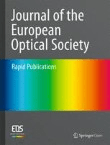
Journal of the European Optical Society-Rapid Publications
Bridging Ideas with Speed in Optical ResearchJournal of the European Optical Society-Rapid Publications, with ISSN 1990-2573 and published by EDP Sciences S A, is a premier open access journal dedicated to advancing the field of optics and photonics since its inception in 2006. Based in France, this journal serves as a vibrant platform for researchers, professionals, and students to disseminate their findings quickly and efficiently. Achieving a commendable Q3 ranking in Atomic and Molecular Physics and Optics (2023), it reflects a growing impact within the scientific community, despite currently holding a 33rd percentile rank among similar publications in the realm of Physics and Astronomy. The journal fosters an environment of rapid communication and collaboration, making it an invaluable resource for those interested in the latest developments and innovations in optical sciences. With open access ensuring broad visibility for all published work, the Journal of the European Optical Society-Rapid Publications is positioned as a key contributor to enhancing the understanding and application of optical technologies.

Computer Optics
Bridging Disciplines: Where Optics Meets TechnologyComputer Optics is a prominent academic journal dedicated to advancing the field of optics and its integration with computer science, published by the IMAGE PROCESSING SYSTEMS INST of the Russian Academy of Sciences. With an ISSN of 0134-2452 and an E-ISSN of 2412-6179, this journal has been a vital resource for researchers and professionals since it became Open Access in 1987, promoting the free dissemination of knowledge. Based in Samara, Russia, Computer Optics covers a broad range of relevant topics, with its scope spanning atomic and molecular physics, optics, computer vision, and electrical engineering. Although characterized within Q4 and Q3 quartiles in various categories in 2023, its rigorous peer-review process ensures the publication of high-quality research contributions. The journal is crucial for those wishing to explore interdisciplinary approaches that merge practical applications of optics with cutting-edge computer technologies, thereby acting as a bridge between these dynamic fields.

Optoelectronics Letters
Exploring the Intersection of Light and ElectronicsOptoelectronics Letters, published by Tianjin University of Technology, is an esteemed platform for the dissemination of innovative research within the fields of atomic and molecular physics, optics, condensed matter physics, and electrical engineering. With its inaugural publication in 2007 and a convergence period extending to 2024, this journal aims to foster scholarly communication and collaboration among researchers and professionals. Although currently lacking an impact factor, it serves a vital niche in the rapidly evolving field of optoelectronics, evidenced by its categorization in the fourth quartile for various physics disciplines and the third quartile in electrical and electronic engineering. Given its ranking dynamics in Scopus, it is an emerging choice for authors seeking to convey their findings on electronic, optical, and magnetic materials. Researchers, students, and industry professionals alike can benefit from its open access options, encouraging a broad dissemination of cutting-edge knowledge that is essential in the advancement of technology and materials science.
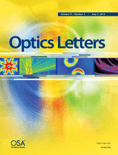
OPTICS LETTERS
Exploring New Frontiers in Light and MatterOPTICS LETTERS is a premier academic journal published by the Optica Publishing Group, dedicated to advancing the field of optics and photonics. Since its inception in 1977, it has maintained a strong reputation for publishing high-impact research, holding a distinguished Q1 category ranking in Atomic and Molecular Physics, as well as Optics, making it a vital resource for researchers and professionals alike. With an impressive Scopus rank of #55 out of 224 in its field, OPTICS LETTERS continues to shape the discourse and innovation in optical science. Authors benefit from its extensive international reach, while readers gain access to cutting-edge studies that address both theoretical and applied aspects of optics. Although the journal currently does not offer open access options, its rigorous peer-review standards ensure that every publication meets the highest academic criteria, making it an essential journal for anyone looking to stay at the forefront of optical research.

Optica
Connecting researchers with groundbreaking insights.Optica is a premier open-access journal published by the Optica Publishing Group, designed to disseminate high-quality research across the fields of Atomic and Molecular Physics and Optics. Since its inception in 2014, it has established itself as a vital resource for the scientific community, as evidenced by its impressive Q1 rankings in both relevant categories in 2023 and its notable positions in the Scopus rankings—#9 in Atomic and Molecular Physics and #13 in Materials Science. Featuring cutting-edge research from leading experts, Optica aims to foster innovation and collaboration by providing unrestricted access to groundbreaking discoveries and advancements. Researchers, professionals, and students alike will find invaluable insights and trends that drive the ever-evolving scope of optical science and materials technology. With its commitment to open access, Optica ensures that knowledge is accessible, empowering the global community of scientists and researchers to embark on new explorations.
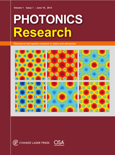
Photonics Research
Unveiling the Potential of Light-Based TechnologiesPhotonics Research, published by Chinese Laser Press, is a premier international journal that aims to disseminate cutting-edge research and advancements in the field of photonics, encompassing areas such as atomic and molecular physics, optics, and materials science. Since its inception in 2013, this journal has established itself as a vital resource for academics and professionals, reflected in its impressive Q1 rankings in both Atomic and Molecular Physics, and Optics (15/224) and Electronic, Optical and Magnetic Materials (26/284) as per Scopus, underscoring its influence within the scientific community. With substantial contributions to the field, Photonics Research continues to foster innovation and collaboration among researchers, serving as an essential platform for the publication of high-quality studies that push the boundaries of knowledge. The journal operates on an open-access model, ensuring that research is readily available to a global audience, thereby enhancing its accessibility and impact. Whether you are a researcher, student, or professional, engaging with this journal offers a significant opportunity to stay at the forefront of photonic technologies and ideas.
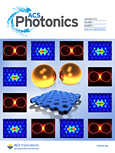
ACS Photonics
Pioneering Breakthroughs in Optics and BeyondACS Photonics, published by the American Chemical Society, is a leading journal dedicated to advancing the interdisciplinary fields of photonics and optics. Since its inception in 2014, the journal has swiftly established itself as a premier platform for the dissemination of groundbreaking research, achieving a distinguished Q1 ranking across several categories including Atomic and Molecular Physics, Biotechnology, Electrical and Electronic Engineering, and Electronic, Optical and Magnetic Materials. With an impressive Scopus Rank and notable percentiles—ranking 19th in Atomic and Molecular Physics and 32nd in Biotechnology—the journal continues to shape the dialogue surrounding innovations in laser technology, optical materials, and biophotonic applications. While the journal does not currently offer open access options, it remains a vital resource for researchers, professionals, and students seeking to explore the cutting-edge developments in this dynamic field. Located in Washington, DC, ACS Photonics is committed to bridging theoretical insights with practical applications, making significant contributions to science and technology.

OPTICAL REVIEW
Advancing Knowledge in Atomic and Molecular PhysicsOPTICAL REVIEW is a distinguished journal published by the Optical Society of Japan that serves as a critical platform for researchers, professionals, and students within the diverse fields of atomic and molecular physics and optics. With its ISSN 1340-6000 and E-ISSN 1349-9432, the journal has had a significant impact on the dissemination of knowledge since its inception in 1994, with a planned coverage until 2024. Although it currently holds a Q4 ranking in the 2023 category quartiles and is positioned at rank #152 out of 224 in the Scopus database, its contributions are vital for advancing optical science. This journal provides a venue for innovative research, review articles, and significant developments that drive the optical sciences forward. Although not categorized as Open Access, it remains an important resource for those seeking to deepen their knowledge and engage with leading-edge research in optics. With its base located at the Kudan-Kita Building in the heart of Tokyo, Germany, OPTICAL REVIEW is poised to continue fostering scholarly communication and collaboration on a global scale.